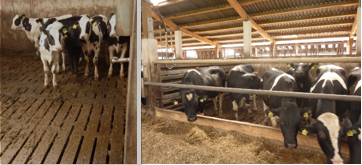 https://ec.europa.eu/eip/agriculture/en/find-connect/projects/bovine-beef-innovation-network-europe
https://ec.europa.eu/eip/agriculture/en/find-connect/projects/bovine-beef-innovation-network-europe
 Picture: F Zerbe 2014
Picture: F Zerbe 2014
Farm experience as well as research with both Limousine and Charolaise bulls during their finishing period in Northern Italian beef farms showed that covering the existing concrete slatted floor with rubber mats in order to prevent slipperiness and traumatic injuries, reduce the occurrence of bulls treated for locomotor problems. Early culling and the occurrence of abnormal lying down as well as unsuccessful attempts to lie down decrease, time for lying down is shortened, bulls’ confidence to exhibit natural behaviors and social interactions is improved by rubberized floors. This flooring system has shown to increase consequently animals’ average daily gain and carcass weight. It’s likely that a higher level of welfare and reduced stressful condition on farm, could improve also bulls’ carcass quality. However, rubber mats mean extra cost, they are said to reduce drainage and promote excessive growth of the claw horn.
A reduced drainage capacity of the floor is impairing the cleanliness of the animals. In case of dirty carcasses, farmers could receive a depreciation of the carcass price. Bull cleanliness is an important hygienic and economic issue at slaughter, as extremely dirty animals could increase the risk of microbial contamination of carcass and meat. There are results that suggest that the soiling of the animals can be kept low with good ventilation of the barn, even on slatted floors with rubber pads. Thus, this disadvantage can be somewhat invalidated and takes a back seat to the advantages for the animals.
Rubber mats on slats have many advantages like the improvement of animal performance, increased animal health and welfare and a reduction of veterinary costs.
This Good Practice has an Impact on:
- Socio-economic resilience: high costs of the installation of rubber mats
- Animal health and welfare: Reduction of costs for treatments of locomotor problems or lameness, and for early culling; improvement of animal welfare and lying comfort
- Production efficiency and meat quality: The improvement of animal performance, such as average daily weight gain and carcass weights, and in consequent reduction of the duration of the fattening cycle could improve feed conversion rate. A higher level of welfare could increase carcass quality
- Environmental Sustainability: the improvement of growth performance and the reduction of the fattening cycle could lead to a higher feed efficiency, to a saving of feedstuffs and water used, and a reduction of gas emission

In terms of rubber mats there are some more Good Practices and Research Innovations on the BovINE Knowledge Hub:
Fattening bulls on slatted floor with perforated rubber mats. Alternative to straw litter.
Rubbermats on slats - the animal welfare version of slats?
The use of rubber coverings/mats on slats to improve animal welfare